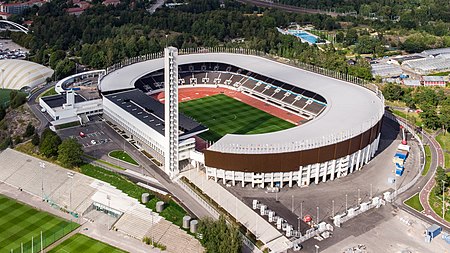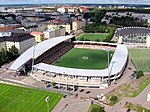Helsinki Olympic Stadium

The Helsinki Olympic Stadium (Finnish: Helsingin Olympiastadion; Swedish: Helsingfors Olympiastadion), located in the Töölö district about 2.3 kilometres (1.4 mi) from the centre of the Finnish capital Helsinki, is the largest stadium in the country, nowadays mainly used for hosting sports events and big concerts. The stadium is best known for being the centre of activities in the 1952 Summer Olympics. During those games, it hosted athletics, equestrian show jumping, and the football finals. The stadium was also the venue for the first Bandy World Championship in 1957, the first World Athletics Championships in 1983 as well as for the 2005 World Championships in Athletics. It hosted the European Athletics Championships in 1971, 1994 and 2012. It is also the home stadium of the Finland national football team. The stadium reopened in August 2020 after 4 years of renovation.
Excerpt from the Wikipedia article Helsinki Olympic Stadium (License: CC BY-SA 3.0, Authors, Images).Helsinki Olympic Stadium
Paavo Nurmen tie, Helsinki Taka-Töölö (Southern major district)
Geographical coordinates (GPS) Address Website External links Nearby Places Show on map
Geographical coordinates (GPS)
| Latitude | Longitude |
|---|---|
| N 60.186944444444 ° | E 24.927222222222 ° |
Address
Helsingin olympiastadion (Stadika)
Paavo Nurmen tie 1
00250 Helsinki, Taka-Töölö (Southern major district)
Finland
Open on Google Maps










